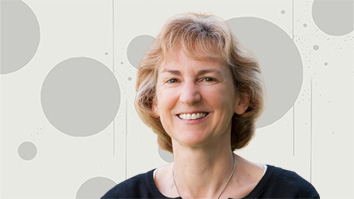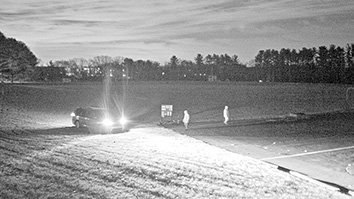
The director of SRI’s AI Center researches AI technologies that complement human capabilities.
Computer scientist Karen Myers has been developing AI technology for decades. She has served on the Association for the Advancement of Artificial Intelligence committee, served on the Artificial Intelligence and the Journal for AI Research editorial boards, and is an SRI Fellow, a designation that recognizes sustained and exceptional technical, scientific, and professional contributions to solving important problems for SRI clients and society.
Here, Myers discusses AI’s new frontiers, her commitment to developing technology that works with humans, and her determination to help lift the next generation of women in AI.
I grew up in Chatham, Ontario, about an hour’s drive east of Detroit. I loved all subjects in school so didn’t really know what I wanted to pursue as a career. I started my undergraduate degree at the University of Toronto with a broad set of classes, including my first course on computers and programming. I really enjoyed the class and decided to major in computer science. I had always loved solving puzzles and mysteries — computer science seemed like an interesting opportunity to combine those kinds of analytical skills with more creative thinking involved in designing software.
I was certainly an anomaly as a woman studying computer science back then. There were almost no women in my courses, and I never had a female professor — both as an undergraduate and graduate student. As an undergraduate, it was hard to connect with my fellow CS students. I think many of them assumed that I wouldn’t be very strong technically, so many weren’t interested in partnering for group projects. It’s hard to know how much of that to attribute to gender; I was often showing up to class with a basketball or badminton racket, which may also have lowered my academic credibility. I ended up having to do several group projects on my own. That meant putting in very long hours, but on the plus side, I learned a lot from those experiences.
Path to SRI
While pursuing my PhD at Stanford, I spent two summers interning at SRI. My doctoral advisor was Nils Nilsson, who had done some incredible research at SRI, including being one of the principals of the Shakey the Robot project. Nils spoke very fondly of his time at SRI and happily arranged internships in the AI Center for several students. After completing my degree in 1991, I was excited to be offered a position at SRI. Based on the exposure I received as an intern, I knew it would be a great environment for starting my research career. Little did I know that I would end up spending my entire career here.
One of my early projects involved building a task planner for Flakey, the successor robot to Shakey. A fun highlight related to that effort was when Alan Alda, the actor and host of the show Scientific American Frontiers, came to record material for a segment on emerging technologies for robotics. The episode featured Flakey roaming the halls to complete delivery and people-finding tasks.
Developing new and collaborative AI
A major focus at SRI has been creating AI technologies designed to complement human problem solving, to enable AI and humans to work effectively with each other. As an example, I’m currently a lead on a project focused on knowledge management for large organizations — how to capture experiential knowledge that can be readily shared with others and how to find the right information when you need it. We’re building a chatbot-style system that can support knowledge capture and retrieval.
One area that excites me is neuro-symbolic AI, which combines data-driven machine learning with traditional AI methods that encode pre-defined knowledge as symbolic rules. This hybrid design enables human expertise to help guide and influence machine learning. This technology has been used for drug design, where insights provided by a medicinal chemist on desired properties for a new molecule can complement properties extracted from collected data on different molecules. Neuro-symbolic AI precompiles knowledge that can significantly reduce the amount of training data required to learn capable models, thus making the learning process faster and cheaper.
“A major focus at SRI has been creating AI technologies designed to complement human problem solving.” — Karen Myers
Our lab is also building systems that allow humans and machines to go a step further than interaction and collaborate to solve a problem. A potential future use for this is in robotic surgery, where a robot could intuitively coordinate its activities with the surgeon on the fly during an operation.
Opening minds to AI
It is very important to me to help women gain a larger foothold in the AI research community. I’m the current advisor for SRI’s Women in Science and Engineering Employee Resource Group, which brings together women from across the institute to discuss research and exchange career tips. Over the years I’ve been involved in various mentoring and networking groups designed to help women connect and learn from each other, with a particular focus on early career. I’m hoping some of the excitement about what we’re doing with AI today will attract many more young women to the field.
I recall one of my fellow graduate students years ago asking, “Why are you throwing away your career studying AI? It’s a dead-end field and will never go anywhere.” I’m glad to see that time has proven him wrong! It’s such an exciting time to be in the field right now, with significant advances happening so quickly that it’s a challenge to keep up. Despite all the progress, there is plenty of research that remains to be done. One important area is how to evaluate AI systems in a principled way, to ensure they meet appropriate levels of reliability and adhere to guardrails on what they should and should not do.



